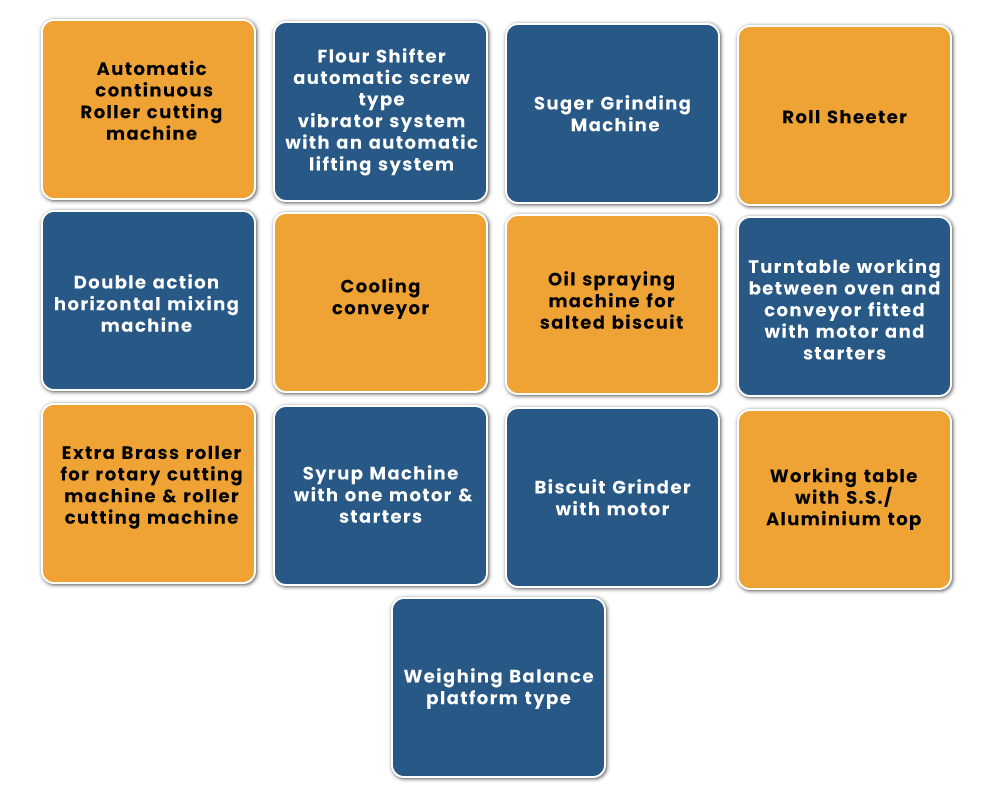This write-up entails a comprehensive plan for Biscuit making business (production unit). Further, it entails a financial analysis with the business permits and licenses you need to start a small manufacturing unit. If you admire baking and have the utmost interest in the food business, it is one of the best ventures for you. Also, it is a growth-driven business model that adheres to unprecedented potential.
Fundamentally, biscuit manufacturing comes under the canopy of the traditional bakery industry.
Generally, there are three different types of ventures that you can start. For newbies, one can commence home-based with minimal investment. The second one is a moderately-sized Biscuit manufacturing unit intending to sell primarily in the domestic market. And another is a medium-sized facility that sells biscuits via an extended distribution network. Either of these models has its pros & cons. But, the second one adheres to better profitability and have better expansion potential.
Read our article:How to Setup a Profitable Meal Prep Business in India?
Comprehensive Roadmap for starting a Biscuit Making Business in India
Here is the detailed blueprint of setting up a legally viable Biscuit Making Business in India;
Step 1: Dig down the key markets for Biscuit making business
The biscuit market has tremendous growth potential and offers better stability to the business owner in the longer term. The successful Biscuit business revolved around effective decision making and informed planning on market identification, packaging and pricing.
Also, ever-increasing health concerns among the masses via digital media are effective in the consumer marketplace. Make sure to facilitate diverse varieties of products at a lucrative price tag as compared to their counterparts.
Step 2: Prepare the Product Portfolio
After doing extensive research of the key market, pinpoint the product that you are willing to offer to the customers. The Indian biscuit market has witnessed a sharp spike in demand during the covid-19 phase owing to an increase in at-home consumption. Milk biscuits as well as Marie in particular, attract more consumers, bringing the rate of growth to almost 12% in 2020. The biscuit market has been evolved drastically over the years. Presently, one can found countless varieties within the Indian marketplace. The most widely consumed are sugar-free, arrowroot, salted, wafer, coconut biscuit, jeera crunch, ginger biscuit, digestive, etc. Therefore, you have to pinpoint what specific type of Biscuit you can produce to maximize the profit. Also, you need to take mould shape into account while selecting the size and shape of the Biscuit you wish to make. Also, you have to jot down the specific recipe as the taste you want to provide to the end-users.
Step 3: Draft the comprehensive Business Plan
The next step is drafting a viable project report or business plan. If you have some experience in the business sector and are accustomed to the technicalities, then you can outline the plan with the aid of the software. There are strings of software available in the market that facilitates pinpoint financial analysis & cost-profit calculations.
But, if you lack the required skill or technical know-how about the production process and raw material, it is better to hire a field expert. The financial aspect of a business plan revolves around the technical part. Here we have mentioned a sample estimation of the project.
Cost of the Project
- Building and infrastructure = INR 35, 00,000
- Plant, Machinery, and equipments = INR 90, 00,000
- Furniture and Misc. = INR 2, 50,000
- Land =INR 2, 50,000
- Preliminary & preoperative expenditure= INR 90,000
- Working capital (3 months) = INR 41, 50,000
Overall cost = INR 1, 7240,000
Step 4: Incorporate your Company
In establishing the Biscuit making business, you need to legalize your establishment via company incorporation. To do so, you first need to choose an appropriate business model (as shown below) and then engage with the relevant incorporation process as recommended by respective bylaws.
- LLP (comes under LLP Act, 2008)
- OPC (Governed by Company Act, 2013)
- Private limited company (Governed by Company Act, 2013)
- Partnership Firm (Partnership Act, 1932)
Step 5: Establish a manufacturing Facility
The next step is to set up a manufacturing facility. In general, a production facility must have ample area for storage, production, packaging, and transportation. The size of the production facility fundamentally depends on the production capacity. In general, you can set up a moderate size biscuit manufacturing unit within the area of 1500 Sq Ft. Determine the availability of power, potable water supply, & transportation facility nearby the production unit location.
Step 6: Procure required Machinery for Biscuit making business
Generally, you can establish the production facility on either a semi-automatic or fully automatic basis. It is suitable to opt for a semi-automatic option to run a small-scale unit. Also, the particular equipment requirement revolves around the production process as well as production capacity. Following is the list of equipment that is usually found on Biscuit making plants.


Step 7: Identify the Viable Sources of Raw material
In commercial Biscuit making business, you need to ensure an uninterrupted supply of wheat flour to the production facility. Apart from that, you also need to arrange the raw material like sugar, yeast, salt, milk powder, flavour, edible colours, etc. Furthermore, you also need to procure the packaging consumables from the trusted sources. Make sure that the packaging should be consumer-friendly and entails FSSAI’s recommended information to promote food safety.
Step 8: Avail BIS and Food License from Relevant Authority
BIS and Food licenses are the two most important permits for production facilities engaged with the food items. BIS grants BIS certification after an extensive verification process conducted by the BIS officials. To apply for this license, one has to visit the manak online portal and fill the relevant e-form accompanied by the requested documentation. Keep in mind that the BIS certification process is a complex undertaking for any business. So it is advisable to stick around with a field expert while applying for the same.
A food license is another mandatory requirement for food business operators in India. As per the FSS Act, 2006[1], the food license is granted by the FSSAI (aka Food Safety and Standards of India) based on the eligibility criteria that revolves around annual turnover, product capacity and scope of operation.
Step 9: Get the Factory License
Factory license is a legal compulsion for an entity that leverages specific machinery and workforce to undertake their in-house production operation. As per the Factory Act, 1948, the Chief Inspector of Labour Commissioner Organisation holds the right to disburse this license against the duly filed e-form and attest documents.
Step 10: Commence the Operation as per BIS guidelines
Once you secure the licenses above, make sure to commence the operation in view of BIS guidelines as mentioned below:
- Refer IS 5059 to maintain hygiene protocols for biscuit manufacturing.
- The baking should be spot on, and Biscuit should bear the uniform texture and appearance
- The design of Biscuit should be uniform throughout the production lot.
- The biscuits should be free from insect infestation and fungus, rancid taste & odour.
- The biscuits should be free from foreign particles.
Step 11: Quality Control
Quality control and GMP (Good Manufacturing Practice) plays a vital role the biscuit production in a full-fledged manufacturing unit. The manufacturers are mandated to align themselves with the BIS specifications. Also, testing the production lot before packaging ensures the utmost quality of the Biscuit. All personal who visit the production facility must be accustomed to the underlying hygiene protocols.
Step 12: Ensure standardized packing and marking
BIS has underpinned the following guidelines for the Biscuit making businesses regarding the packing and marking:
- Biscuits shall be packed in clean made of PCRC, tin plate, paper, cardboard or other material agreed upon between the buyer & the vendor.
- The packaging should be done to protect the production lot from possible contaminations, breakage, and absorption of moisture.
- Isolate the production lot from packaging materials other than sulphite paper, greaseproof, food-grade plastic, and non-toxic plastic material.
- The production lot should not be placed in close proximity to unlacquered metal walls.
- Biscuit packets weighing 150 grams and higher, a complaint slip manifesting the code number should be attested to the container.
- Biscuit packets should be marked with the details such as product name, trade name, name & address of the production facility, batch number, etc.
Step 13: Set up a Distribution & Marketing channel
Distribution refers to the process of getting the product in front of the target customers. The trading of goods & services often seems remarkably simple & straightforward, but it never is. Distribution is a complex & multifaceted affair that seeks the right partner and well thought out strategy.
There are different distribution levels, including direct & indirect channels. The levels tend to increase with the inclusion of intermediaries. A zero-level channel would involve a manufacturer selling directly to target consumers, whereas a three-level channel entails a distributor and a retailer.
There are two fundamental types of distribution channels:
- Direct: End-users purchase the product or service from the manufacturer, whether via an online store or a physical outlet.
- Indirect: End-users purchase the product or service via an intermediary such as retailers.
Channels can be short or long. A short channel entails the few steps between manufacturer and end-user, like with direct marketing. A long channel entails intermediaries such as a retailer & wholesaler.
Conclusion
Setting up a profitable business entity seeks a well-thought business strategy that considers every facet, such as marketing feasibility, future projection, legalities, production, quality, etc. According to many experts, the Biscuit making business is on the rise, and it will continue to garner success over time. Thus, it is the right time to leverage this opportunity and establish a legally viable production unit to access early profit.
Read our article:Let’s Understand the Process of Registering Flour Manufacturing Company in India!











